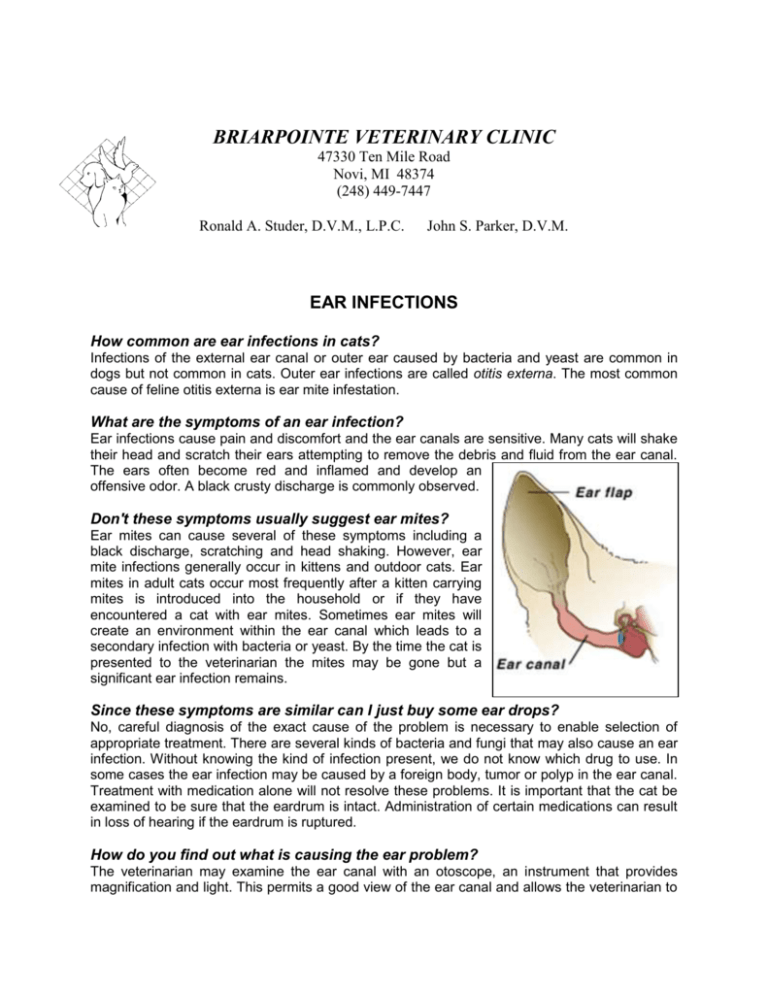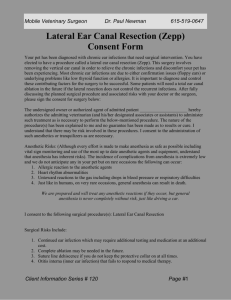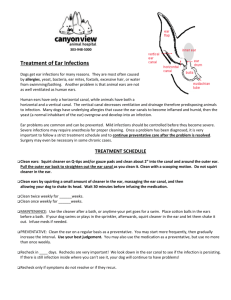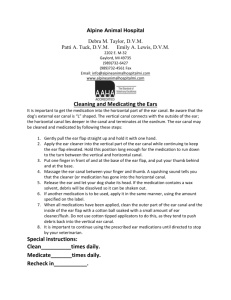EAR INFECTIONS - Briarpointe Veterinary Clinic
advertisement

BRIARPOINTE VETERINARY CLINIC 47330 Ten Mile Road Novi, MI 48374 (248) 449-7447 Ronald A. Studer, D.V.M., L.P.C. John S. Parker, D.V.M. EAR INFECTIONS How common are ear infections in cats? Infections of the external ear canal or outer ear caused by bacteria and yeast are common in dogs but not common in cats. Outer ear infections are called otitis externa. The most common cause of feline otitis externa is ear mite infestation. What are the symptoms of an ear infection? Ear infections cause pain and discomfort and the ear canals are sensitive. Many cats will shake their head and scratch their ears attempting to remove the debris and fluid from the ear canal. The ears often become red and inflamed and develop an offensive odor. A black crusty discharge is commonly observed. Don't these symptoms usually suggest ear mites? Ear mites can cause several of these symptoms including a black discharge, scratching and head shaking. However, ear mite infections generally occur in kittens and outdoor cats. Ear mites in adult cats occur most frequently after a kitten carrying mites is introduced into the household or if they have encountered a cat with ear mites. Sometimes ear mites will create an environment within the ear canal which leads to a secondary infection with bacteria or yeast. By the time the cat is presented to the veterinarian the mites may be gone but a significant ear infection remains. Since these symptoms are similar can I just buy some ear drops? No, careful diagnosis of the exact cause of the problem is necessary to enable selection of appropriate treatment. There are several kinds of bacteria and fungi that may also cause an ear infection. Without knowing the kind of infection present, we do not know which drug to use. In some cases the ear infection may be caused by a foreign body, tumor or polyp in the ear canal. Treatment with medication alone will not resolve these problems. It is important that the cat be examined to be sure that the eardrum is intact. Administration of certain medications can result in loss of hearing if the eardrum is ruptured. How do you find out what is causing the ear problem? The veterinarian may examine the ear canal with an otoscope, an instrument that provides magnification and light. This permits a good view of the ear canal and allows the veterinarian to determine whether the eardrum is intact and if there is a tumor or foreign material in the ear canal. When the ears are extremely painful and the cat refuses to allow ear examination, sedation or general anesthesia may be necessary. The veterinarian may also examine a sample of the material from the ear canal under the microscope. This is called ear cytology and is very important in helping us choose the proper medication for your cat. Some cats have such a heavy build-up of debris that sedation is needed to cleanse the canal and examine it completely. How are ear infections treated? The results of the otoscopic examination and cytology tell us how to properly treat your cat. If there is a foreign body lodged in the ear canal, the cat can be sedated so that it can be removed. Specific medication can be prescribed for bacteria or fungi; sometimes more than one type of infection is identified and this situation requires the use of multiple medications. An important part of the evaluation of the cat is the identification of underlying disease. If this cannot be done the cat is less likely to have a positive response to treatment; the cat may respond temporarily but relapse when the medication is discontinued. Since primary ear infections are uncommon in cats, should I be concerned that something else is going on? Normal cats are very resistant to ear infections. Finding otitis externa in a cat signals us to look for an underlying cause such as an ear mite infestation, an unusual shape of the ear canal or for a disease affecting the cat's immune system. What is the prognosis? In the cat nearly all ear infections that are properly diagnosed and treated can be cured. However, if an underlying cause remains unidentified and untreated the outcome will be less favorable. My cat's ear canal is nearly closed. Is this a problem? Closing of the ear canal occurs when an infection becomes severe and chronic. There are medications that may help shrink the swollen tissues and open the canal in some cats. However, some cases may eventually require surgery. How should I apply medication to my cat's ear? It is important to get the medication into the horizontal ear canal or lower part of the ear canal. The cat’s ear canal is shaped like an “L” and careful attention must be given that you apply the medication into the entire ear canal. This is best done by following these steps: Gently pull the ear flap straight up and hold it with one hand. Apply a small amount of medication in the vertical canal or upper part of the ear canal while continuing to keep the ear flap elevated. Hold this position long enough for the medication to run down to the turn between the vertical and horizontal ear canal. Put one finger in front of and at the base of the ear flap and put your thumb behind at the base. Massage the ear canal between your fingers and thumb. A squishing sound tells you that the medication has gone into the horizontal canal. Release the ear and let your cat shake its head. If the medication contains a wax solvent debris will be dissolved so it can be shaken out. If another medication is to be used apply it in the same manner. When all medications have been applied, clean the outer part of the ear canal and the inside of the ear flap with a cotton ball. Do not use cotton tipped applicators, as they tend to push debris back into the vertical ear canal. Edited by John S. Parker, DVM © Copyright 2005 Lifelearn Inc. Used with permission under license. February 13, 2016






